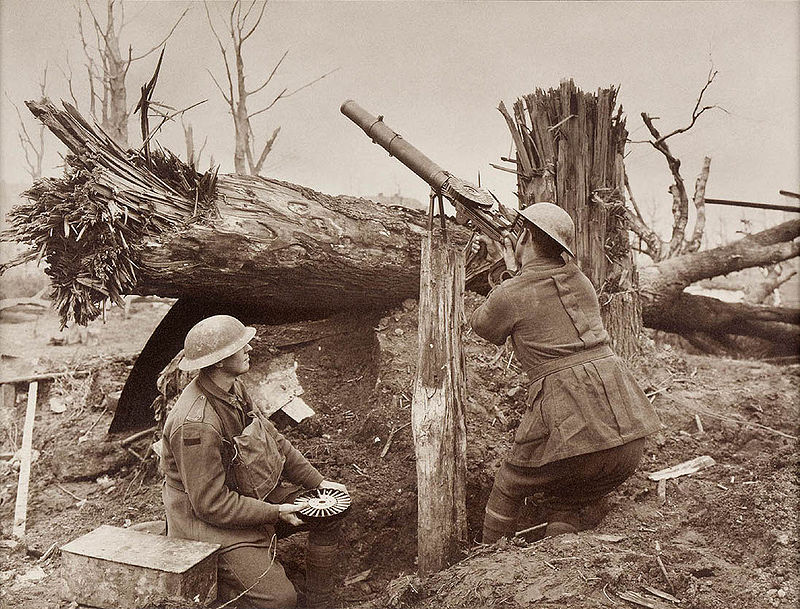aNewDomain — World War I erupted a century ago this week. It was the first truly industrialized war, with inventors, engineers and money guys on all sides feverishly producing weapons of war. Nothing illustrates this fact as well as a tour through the patent databases. I took such a tour and unearthed such key World War I patents as the Brodie helmet, the Lewis machine gun, the flamethrower, the gas mask and the WWI submarine, as deployed.
World War I began, of course, after Serbian Gavrilo Princip assassinated Austrian Archduke Franz Ferdinand in June 2014. The so-called July Crisis ensued. Then, in late July, the Austro-Hungarian Empire declared war on Serbia, and within 14 days of that, Russia declared war on Austro-Hungary, Germany declared war on Russia and France declared war on Germany. The UK entered on Aug. 4, 1914 to come to the aid of France. Thirty countries would eventually become embroiled in what many historians now consider to be the bloodiest war in history. On the battlefield alone, 9 million lives were lost. But it was a watershed year for war tech. All that fighting put into play a range of technologies that, in development since the US Civil War in 1865, were ready for primetime but not widely understood. A great example of this is the World War I era submarine.
The Holland Type VI Submarine
World War I saw the first widespread usage of submarines in war. Versions of submarines had been around for a long time before World War I, but massive, global submarine deployment was new in 1914.
The most famous WWI submarine was the German U-boat. But the Royal Navy and the US Navy relied on the Holland type submarine. Inventor John Philip Holland, who developed his first sub back in 1876, perfected and patented the Holland Type VI submarine in 1896. In the end, Holland received 20 plus patents related to submarines but he never saw them make it a big on the grand scale. He died on Aug. 12, 1914, just as the war was heating up. Check out the patent below. Scroll below the fold to check out the back story and see the patent for the Lewis Machine Gun.
John Philip Holland’s improved submarine patent
Another example of war tech that had been around for a long time before World War I but saw widespread usage in the conflict was the American-designed machine gun.
The Lewis Machine Gun
The Lewis Machine Gun, an American-designed and built weapon, was the British Army’s go-to gun throughout World War I. Designed by Col. Isaac Newton Lewis in 1911 and patented, as you see below, in the UK in 1915, the Lewis gun was versatile. It could be used in the trenches. Anti-aircraft systems used it. And Allied aviators employed it as their primary weapon.
The patent for the Lewis Gun is readable in place, below. Scroll below the fold to see the patents for the Brodie Helmet, the gas mask and more.
UK Patent on the Brodie Steel Helmet
The Brodie Helmet
Soldiers in the early years of the war didn’t have much in the way of head protection. Soft caps were all they had. British soldiers wore cloth caps and German soldiers wore helmets of leather, called Pickelhaube hats. Shrapnel and other flying debris could pass right through them.
Enter Englishman John Leopold Brodie. He invented the steel helmet that Americans, British and Commonwealth soldiers took up and kept on for most of the war.
The Brodie helmet debuted on a 1916 battlefield. As you can see from the patent below, the UK Patent Office in 1916 granted Brodie his helmet patent.
UK Patent on the Brodie Steel Helmet
The Flamethrower
And then there’s the deadly flamethrower, as developed and patented by German Richard Fiedler. Fiedler invented several versions of his Flammenwerfer in 1901 and submitted the final design to the German Army. Yet, in classic inventor style, Fiedler continued to make improvements to his original design. Check out the patent below, which he submitted to the UK Patent Office in 1910. Just four years later, German soldiers would be using his weapon against British soldiers, though. And the weapon was so deadly and so efficient that it wasn’t long before most countries in World War I used them, too.
UK version of Richard Fiedler’s flamethrower patent
The Gas Mask
Poison gas is horrible weapon that debuted during World War I. Though the Hague Conventions of 1899 and 1907 had banned it, Germany — and later the world — made liberal use of the noxious stuff. Invention being the usual mother of necessity, the gas mask was born.
Gas masks and respirators had been invented as early as 1799 by Alexander von Humboldt. And a handful of inventors came up with successful military gas masks along the way. But it was African-American inventor Garrett Morgan who nabbed the 1914 patent for a simple mask that, with a long tube that trailed the ground, let soldiers escape the bad air and breathe presumably better stuff closer to the ground. That patent is below. Check it out.
Garrett Morgan’s US Patent on a Gas Mask
All World War I patent photos courtesy Wikimedia Commons.
For aNewDomain, I’m Tom Ewing.
Tom is a co-founder of aNewDomain. When he’s not writing for aNewDomain or cutting deals for us, Tom Ewing is a globe trotting international IP lawyer and forensics expert, an intellectual property strategy at Avancept and a writer at ArchimedesIP. Follow Tom on on Google + here.














[…] Five World War I Patents: War Tech Roundup […]